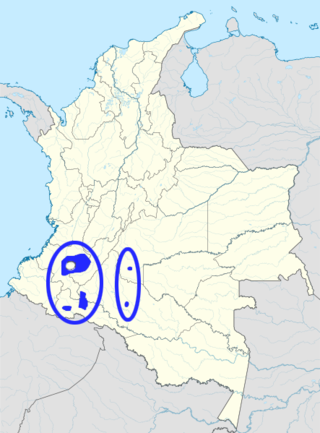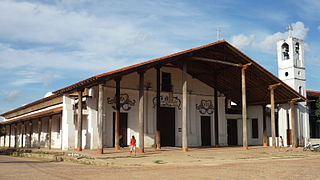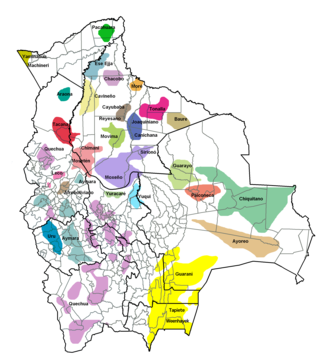
Trinidad, Kimsantin officially La Santísima Trinidad, is a city in Bolivia, capital of the department of Beni. The population is 130,000. While historically a peripheral city in Bolivia, Trinidad is today an important center for the Bolivian Bovine industry and has enjoyed a modest economic boom in recent years and enjoys an HDI index of above 0.700.

Arawakan, also known as Maipurean, is a language family that developed among ancient indigenous peoples in South America. Branches migrated to Central America and the Greater Antilles in the Caribbean and the Atlantic, including what is now the Bahamas. Almost all present-day South American countries are known to have been home to speakers of Arawakan languages, the exceptions being Ecuador, Uruguay, and Chile. Maipurean may be related to other language families in a hypothetical Macro-Arawakan stock.

Puquina is a small, putative language family, often portrayed as a language isolate, which consists of the extinct Puquina language and Kallawaya, although it is assumed that the latter is just a remnant of the former mixed with Quechuan. The Qhapaq simi, which was spoken by the Inca elite, in contrast to the Quechuan-speaking commoners, is thought to be related, as well as the Leco isolate language. They are spoken by several native ethnic groups in the region surrounding Lake Titicaca and in the north of Chile. Puquina itself is often associated with the culture that built Tiwanaku.

Páez is a language of Colombia, spoken by the Páez people. Crevels (2011) estimates 60,000 speakers out of an ethnic population of 140,000.
The Piaroa–Saliban, also known as Saliban, are a small proposed language family of the middle Orinoco Basin, which forms an independent island within an area of Venezuela and Colombia dominated by peoples of Carib and Arawakan affiliation.

The languages of Bolivia include Spanish; several dozen indigenous languages, most prominently Aymara, Quechua, Chiquitano, and Guaraní; Bolivian Sign Language ; and languages of immigrants such as Plautdietsch. Indigenous languages and Spanish are official languages of the state according to the 2009 Constitution. The constitution says that all indigenous languages are official, listing 36 specific languages, of which some are extinct. Spanish and Quechua are spoken primarily in the Andes region, Aymara is mainly spoken in the Altiplano around Lake Titicaca, Chiquitano is spoken in the central part of Santa Cruz, and Guaraní is spoken in the southeast on the border with Paraguay.
Bauré is an endangered Arawakan language spoken by only 40 of the thousand Baure people of the Beni Department of northwest of Magdalena, Bolivia. Some Bible portions have been translated into Bauré. Most speakers have been shifting to Spanish.

The Mojeños, also known as Moxeños, Moxos, or Mojos, are an indigenous people of Bolivia. They lived in south central Beni Department, on both banks of the Mamore River, and on the marshy plains to its west, known as the Llanos de Mojos. The Mamore is a tributary to the Madeira River in northern Bolivia.
Loreto is a smalI municipality in the Beni Department in northern Bolivia, capital of the Marbán Province and Loreto Municipality. In 2001, Loreto had a population of 843.

San Ignacio de Moxos is a town in the Beni Department of northern Bolivia.

San Joaquín is a small agricultural town in the Beni Department in the Bolivian lowlands.
San Javier (Beni) is a small town in Bolivia.
Cayubaba is a moribund language of the Bolivian Amazon. The Cayubaba people inhabit the Beni region to the west of the Mamoré River, North of the Santa Ana Yacuma, with a population of 794 inhabitants.
The Intercontinental Dictionary Series is a large database of topical vocabulary lists in various world languages. The general editor of the database is Bernard Comrie of the Max Planck Institute for Evolutionary Anthropology, Leipzig. Mary Ritchie Key of the University of California, Irvine is the founding editor. The database has an especially large selection of indigenous South American languages and Northeast Caucasian languages.
Chimané (Tsimané) is a South American language isolate. Some dialects are known as Mosetén. Chimane is a language of the western Bolivian lowlands spoken by the Tsimane peoples along the Beni River and the region around San Borja in the Department of Beni (Bolivia). Sakel (2004) classifies them as two languages for a number of reasons, yet some of the variants of the language are mutually intelligible and they reportedly have no trouble communicating and were evidently a single language separated recently through cultural contact.
The Pauna language, Paunaka, is an almost unknown Arawakan language in South America. It is an extremely endangered language, which belongs to the southern branch of the Arawakan language family and it is spoken in the Bolivian area of the Chiquitanía, near Santa Cruz and north of the Chaco region. The suffix -ka is a plural morpheme of the Chiquitano language, but has been assimilated into Pauna.

The indigenous languages of the Americas form various linguistic areas or Sprachbunds that share various common (areal) traits.

The Llanos de Moxos, also known as the Llanos de Mojos and the Beni Savanna, have extensive remains of pre-Columbian agricultural societies scattered over most of Beni Department, Bolivia. The remains testify to a well-organized and numerous indigenous people. This contradicts the traditional view of archaeologists, notably Betty Meggers, who asserted that the Amazon River Basin was not environmentally able to sustain a large population and that its indigenous inhabitants were hunter-gatherer bands or slash-and-burn farmers. In the 1960s, petroleum company geologists and geographer William Denevan were among the first to publicize the existence of extensive prehistoric earthworks constructed in the Amazon, especially in the Llanos de Moxos.

The Jesuit Missions of Moxos are located in the Llanos de Moxos of Beni department in eastern Bolivia. Distinguished by a unique fusion of European and Amerindian cultural influences, the missions were founded as reductions or reducciones de indios by Jesuits in the 17th and 18th centuries to convert local tribes to Christianity.

The Mamoré–Guaporé linguistic area is a linguistic area that includes over a dozen South American language families and isolates of the Mamoré–Guaporé region of eastern lowland Bolivia and Brazil.












